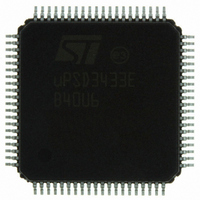UPSD3433EB40U6 STMicroelectronics, UPSD3433EB40U6 Datasheet - Page 146

UPSD3433EB40U6
Manufacturer Part Number
UPSD3433EB40U6
Description
MCU 8BIT 8032 128KB FLASH 80TQFP
Manufacturer
STMicroelectronics
Series
µPSDr
Datasheet
1.UPSD3434EB40T6.pdf
(293 pages)
Specifications of UPSD3433EB40U6
Core Processor
8032
Core Size
8-Bit
Speed
40MHz
Connectivity
I²C, IrDA, SPI, UART/USART, USB
Peripherals
LVD, POR, PWM, WDT
Number Of I /o
46
Program Memory Size
160KB (160K x 8)
Program Memory Type
FLASH
Ram Size
8K x 8
Voltage - Supply (vcc/vdd)
3 V ~ 5.5 V
Data Converters
A/D 8x10b
Oscillator Type
Internal
Operating Temperature
-40°C ~ 85°C
Package / Case
80-TQFP, 80-VQFP
For Use With
497-5518 - EVAL BOARD RFID READER497-5046 - KIT TOOL FOR ST7/UPSD/STR7 MCU
Lead Free Status / RoHS Status
Lead free / RoHS Compliant
Eeprom Size
-
Other names
497-5660
Available stocks
Company
Part Number
Manufacturer
Quantity
Price
Company:
Part Number:
UPSD3433EB40U6
Manufacturer:
STMicroelectronics
Quantity:
10 000
- Current page: 146 of 293
- Download datasheet (5Mb)
USB interface
25.1.4
146/293
The data packet contains a DATA1 or DATA0 PID. In a USB system, the host or device that is
sending data is responsible for toggling the data PID between DATA0 and DATA1. The
receiving device keeps track of the Toggle Bit and compares it with the data PID that is
received. This provides a means for the receiving host or device to detect a corrupted
handshake packet. The Payload Data is the data that the host is sending to the device and
the CRC16 is used for error checking.
For an OUT transaction, the host sends the token and data packets. The receiving device
sends a handshake packet to notify the host whether it was able to accept the packet or not.
There are three handshake PIDs as follows:
●
●
●
Figure 50. USB Packets in a USB Transfer Example
Data transfers with the host
The host issues OUT tokens followed by Data Tokens to send data to a device. The device
responds with an appropriate handshake packet (ACK/NAK), indicating whether it was able
to receive the data. If the device does not receive the data packet OK (because there is
some error), it does not respond with a handshake packet. In the case of a NAK or no
response, the host retries sending the data at a later time.
USB devices are not able to send data to a host whenever they have it ready. When a device
has data ready, it loads data into its endpoint buffer, making it ready for a transfer. The data
will remain in the buffer until the host issues an IN token to that device’s endpoint, at which
time the data will be sent. If the host receives the data OK, it follows with an ACK handshake
(a host never NAKs). If the host did not receive the data OK, there is no handshake packet.
In this case, the device should reload its endpoint buffer as appropriate and the host will
retry again later to retrieve the data.
ACK: this PID indicates that the device received the data successfully.
NAK: this handshake indicates that the device was not able to receive the data (it is
busy). A NAK does not mean there was an error, since errors are indicated by a “no
handshake” packet. When the host receives a NAK PID or does not receive a
handshake packet at all, the host retries sending the data at a later time.
STALL: this handshake indicates that something is wrong. For example, the host has
sent a device request that is not understood, the host is trying to access a resource that
is not available, or something is wrong with the device.
OUT
OUT
ADDR
ADDR
Token Packet
Token Packet
1
4
ENDP
ENDP
CRC5
CRC5
Data1
Data0
Data Packet
Data Packet
Payload
Payload
Data
Data
2
5
CRC16
CRC16
Handshake Packet
Handshake Packet
ACK
ACK
3
6
AI10489
uPSD34xx
Related parts for UPSD3433EB40U6
Image
Part Number
Description
Manufacturer
Datasheet
Request
R

Part Number:
Description:
MCU 8BIT 8032 128KB FLASH 80TQFP
Manufacturer:
STMicroelectronics
Datasheet:

Part Number:
Description:
MCU 8BIT 8032 128KB FLASH 52TQFP
Manufacturer:
STMicroelectronics
Datasheet:

Part Number:
Description:
STMicroelectronics [RIPPLE-CARRY BINARY COUNTER/DIVIDERS]
Manufacturer:
STMicroelectronics
Datasheet:

Part Number:
Description:
STMicroelectronics [LIQUID-CRYSTAL DISPLAY DRIVERS]
Manufacturer:
STMicroelectronics
Datasheet:

Part Number:
Description:
BOARD EVAL FOR MEMS SENSORS
Manufacturer:
STMicroelectronics
Datasheet:

Part Number:
Description:
NPN TRANSISTOR POWER MODULE
Manufacturer:
STMicroelectronics
Datasheet:

Part Number:
Description:
TURBOSWITCH ULTRA-FAST HIGH VOLTAGE DIODE
Manufacturer:
STMicroelectronics
Datasheet:

Part Number:
Description:
Manufacturer:
STMicroelectronics
Datasheet:

Part Number:
Description:
DIODE / SCR MODULE
Manufacturer:
STMicroelectronics
Datasheet:

Part Number:
Description:
DIODE / SCR MODULE
Manufacturer:
STMicroelectronics
Datasheet:

Part Number:
Description:
Search -----> STE16N100
Manufacturer:
STMicroelectronics
Datasheet:

Part Number:
Description:
Search ---> STE53NA50
Manufacturer:
STMicroelectronics
Datasheet:











